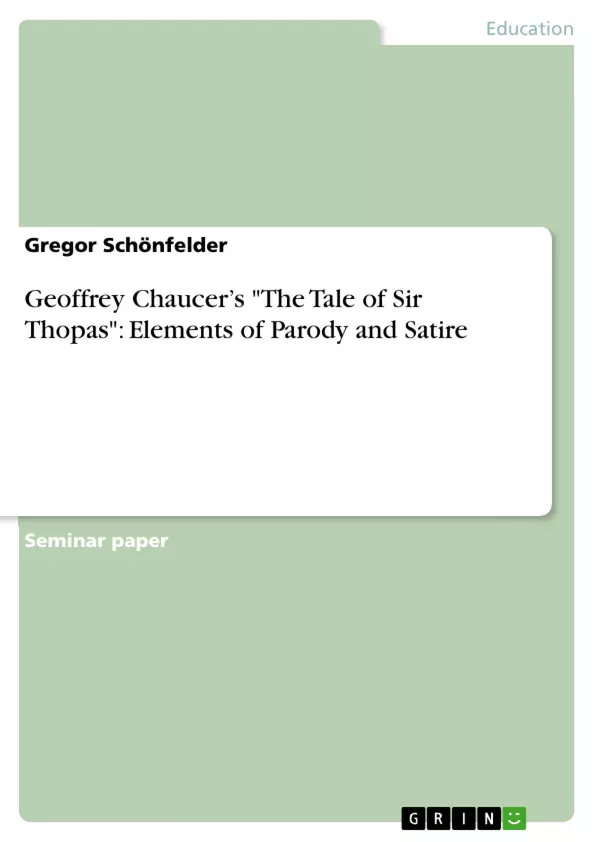In this work, I examine "The Tale of Sir Thopas" by Geoffrey Chaucer regarding its verious elements of parody. The tale mocks the typical medieval romance, therefore it is first necessary to estabish what the term "romance" means in this context. Then, the various parodied aspects of content will be examined, including Sir Thopas himself, his not-so-heroic battles, and love. However, formal aspects as well have been heavily parodied in Sir Thopas and will be in focus, namely rhyming, descriptions, the minstrel's introduction as well as the general structure of the tale, including its end.
Inhaltsverzeichnis (Table of Contents)
- Introduction
- The Medieval Romance
- Parodied Aspects of Content
- Sir Thopas the Anti-Hero
- Sir Thopas and His \"Almost-Battle\"
- Love in Sir Thopas and Romances
- Parodied Formal Aspects
- Rhyming
- Mechanical Style in Descriptions
- Introductions by the Minstrel
- Structure and a Fitting End
- Conclusion
Zielsetzung und Themenschwerpunkte (Objectives and Key Themes)
This paper aims to provide an insight into Chaucer's parody of the medieval romance genre in "The Tale of Sir Thopas." It examines how Chaucer utilizes humor and satire to create a humorous and absurd depiction of a popular literary genre, highlighting the contrasting elements and expectations of the traditional romance.
- Parody of Medieval Romance Conventions
- Analysis of Sir Thopas as an Anti-Hero
- Exploration of Parodied Formal Aspects
- Chaucer's Unique Style of Humor and Writing
- The Evolution of Critical Perspectives on "The Tale of Sir Thopas"
Zusammenfassung der Kapitel (Chapter Summaries)
- Introduction: This chapter introduces the context of "The Tale of Sir Thopas" within The Canterbury Tales and outlines the paper's focus on analyzing Chaucer's parody of the medieval romance genre. It also discusses the historical reception of "Sir Thopas" and how it was initially perceived as a serious romance before being recognized as a parody.
- The Medieval Romance: This chapter provides a general overview of the medieval romance genre, its origins, and its key features, including the typical narrative elements, themes, and presentation by minstrels. It emphasizes the popularity of the genre and its role as a target for Chaucer's satire.
- Parodied Aspects of Content: This chapter explores how Chaucer parodies the content of traditional romances through the character of Sir Thopas. It analyzes Sir Thopas' name, lineage, appearance, and actions as contradictions to the expected qualities of a romantic hero. It also examines how Chaucer subverts the typical depiction of love and battle in romances.
Schlüsselwörter (Keywords)
This paper focuses on key concepts such as parody, satire, medieval romance, anti-hero, genre conventions, formal aspects, Chaucerian humor, and critical reception. It also explores the themes of chivalry, love, battle, and social norms in the context of Chaucer's satirical treatment of the medieval romance genre.
- Citar trabajo
- Gregor Schönfelder (Autor), 2010, Geoffrey Chaucer’s "The Tale of Sir Thopas": Elements of Parody and Satire, Múnich, GRIN Verlag, https://www.grin.com/document/202391



